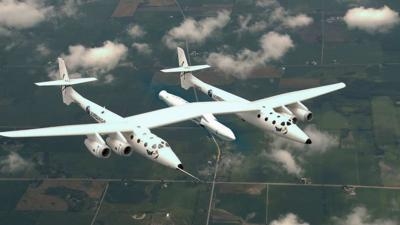Fri, Jan 16, 2015
WhiteKnightTwo Reconfigured To Carry LauncherOne
While every other gadget in our lives has gotten smaller, lighter, and cheaper, satellite technology has somehow gotten bigger, heavier, and more expensive since the days of Sputnik and Explorer I. But now, thanks to the recent advances in Cubesats and microsatellites, commercial satellite start-ups, universities, schools, and even IndieGoGo campaigns can put their own satellites into space. But small satellites need small satellite launch vehicles—after all, small satellites cannot truly change the world without cost-effective, frequent rides to space!

Current small and microsatellites reached space mostly by “hitchhiking” — catching a ride on someone else’s big, expensive rocket. But hitchhiking to space has real drawbacks: just like hitchhiking here on Earth, when you leave and where you get dropped off aren’t your decisions to make, and the driver probably has strict rules about what you can and can’t do in the vehicle. If you are just trying to prove that your satellite works in space, those restrictions may be fine, but if you are trying to build a business or accomplish a mission, you need your own ride, at the right price.
The makers, builders, and satellite entrepreneurs have done their part. It’s time for the rockets to do theirs. Sir Richard Branson says it’s time for LauncherOne.
Virgin Galactic, says they are leveraging its work building their human spaceflight program and its team’s extensive background in low-cost launch systems to create LauncherOne, an orbital launch vehicle dedicated to the small satellite market. By using much of the same infrastructure originally that supports SpaceShipTwo — in particular WhiteKnightTwo, our unique, high-performance mothership — the company says it can keep prices low while accommodating customer needs for launch availability and flexibility.
Branson said on the Virgin Galactic website that they are "hard at work finalizing the design for LauncherOne and testing its key components. LauncherOne will be a two-stage rocket, built using advanced composite structures, and powered by our new family of LOX/RP-1 liquid rocket engines. Each LauncherOne mission will be capable of delivering as much as 225 kilograms (500 pounds) to a low inclination Low Earth Orbit or 120 kilograms (265 pounds) to a high-altitude Sun-Synchronous Orbit, for a price of less than $10M. The customers we’ve already announced plan to use LauncherOne to take pictures of the Earth for humanitarian causes, to collect more accurate weather measurements, to hunt for asteroids that could represent threats and opportunities to our home planet, and to launch many other types of satellites. We’re convinced that the types of missions are only the tip of the proverbial iceberg."
More News
Terminal Radar Service Area Airspace surrounding designated airports wherein ATC provides radar vectoring, sequencing, and separation on a full-time basis for all IFR and participa>[...]
Aero Linx: Utah Back Country Pilots Association (UBCP) Through the sharing experiences, the UBCP has built upon a foundation of safe operating practices in some of the most challen>[...]
From 2010 (YouTube Edition): Imagine... Be The Change... Inspire FROM 2010: One of the more unusual phone calls I have ever received occurred a few years ago... from Anousheh Ansar>[...]
(Pilot) Felt A Shudder And Heard The Engine Sounding Differently, Followed By The Engine Chip Detector Light On April 14, 2025, about 1800 Pacific daylight time, a Bell 206B, N1667>[...]
Also: AMA Names Tyler Dobbs, More Falcon 9 Ops, Firefly Launch Unsuccessful, Autonomous F-16s The Air Force has begun ground testing a future uncrewed jet design in a milestone tow>[...]
 ANN's Daily Aero-Term (05.07.25): Terminal Radar Service Area
ANN's Daily Aero-Term (05.07.25): Terminal Radar Service Area ANN's Daily Aero-Linx (05.07.25)
ANN's Daily Aero-Linx (05.07.25) Classic Aero-TV: Anousheh Ansari -- The Woman Behind The Prize
Classic Aero-TV: Anousheh Ansari -- The Woman Behind The Prize NTSB Prelim: Bell 206B
NTSB Prelim: Bell 206B Airborne-NextGen 05.06.25: AF Uncrewed Fighters, Drones v Planes, Joby Crew Test
Airborne-NextGen 05.06.25: AF Uncrewed Fighters, Drones v Planes, Joby Crew Test



